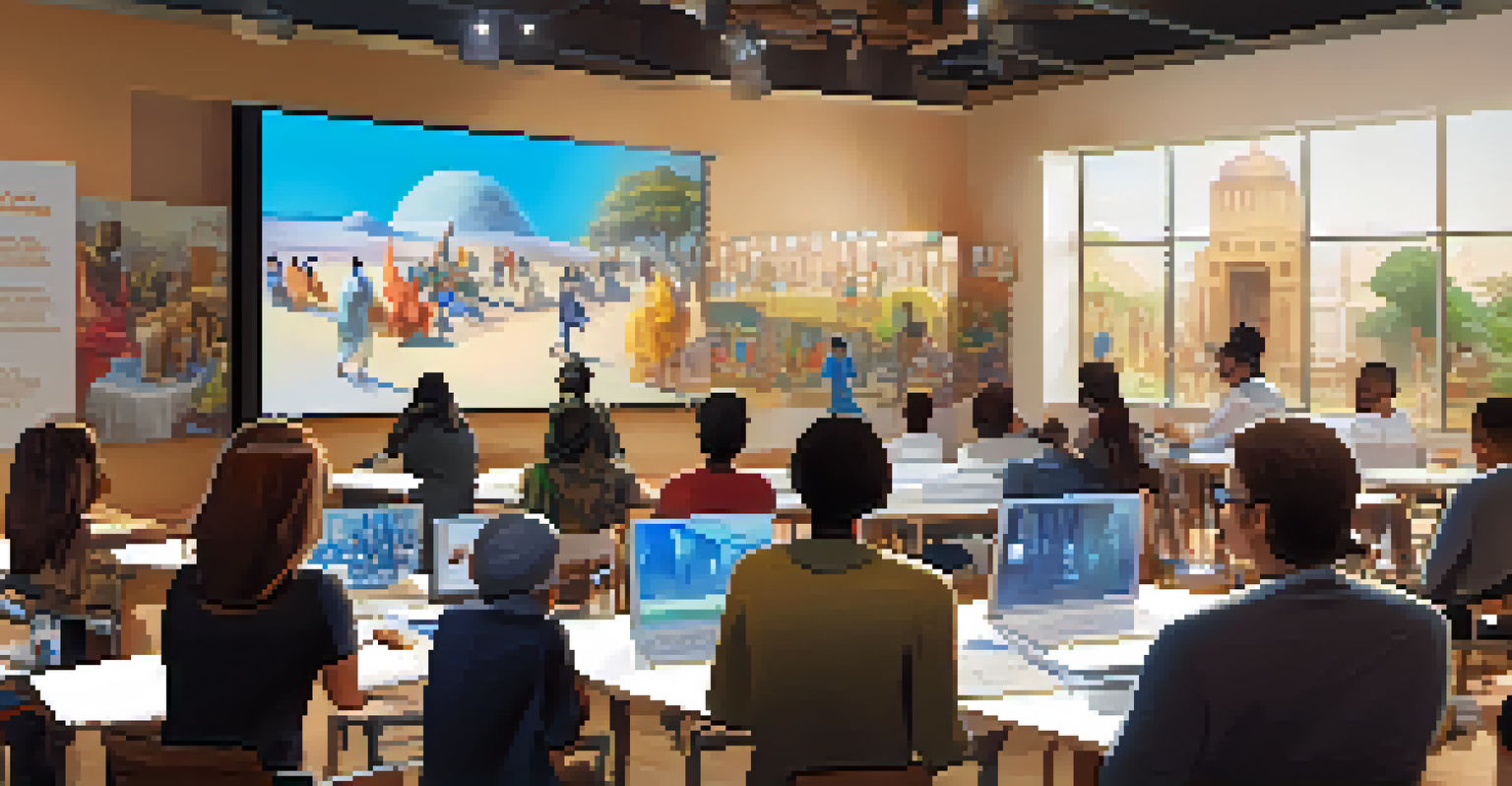Enhancing Cultural Competence through Blended Learning

Understanding Cultural Competence in Today's World
Cultural competence is the ability to understand, communicate with, and effectively interact with people across cultures. In our increasingly globalized world, this skill is more important than ever. It helps individuals navigate diverse environments, fostering collaboration and reducing misunderstandings.
Cultural competence is not the end result, but rather the beginning of a journey to understanding and valuing diversity.
Imagine walking into a room filled with people from various backgrounds. Cultural competence equips you to engage meaningfully, respecting differences while finding common ground. It’s not just about awareness; it's about action and empathy, ensuring everyone feels valued and understood.
By enhancing cultural competence, organizations can promote inclusivity and improve team dynamics. Ultimately, this leads to better decision-making and innovation, as diverse perspectives contribute to a richer tapestry of ideas.
What is Blended Learning and Why Use It?
Blended learning combines traditional face-to-face instruction with online learning components. This approach offers flexibility, allowing learners to absorb information at their own pace while still benefiting from direct interactions. It's like having the best of both worlds, tailored to suit various learning styles.

Consider blended learning as a buffet: learners can choose what they want to engage with, from online discussions to in-person workshops. This personal touch makes cultural competence training more effective, as participants can reflect on their experiences and learn from others in a more relaxed setting.
Cultural Competence is Essential
Understanding and interacting with diverse cultures is crucial in today's globalized world.
Moreover, blended learning can be particularly beneficial in fostering cultural competence. By integrating digital tools with real-world interactions, educators can create diverse learning experiences that challenge biases and broaden perspectives.
The Role of Online Modules in Cultural Training
Online modules serve as a foundation for cultural competence training, providing essential knowledge and resources. They can cover various topics, from cultural norms to communication styles, equipping learners with the information they need before engaging in discussions or activities.
In a multicultural society, understanding cultural differences is crucial for effective communication and collaboration.
Think of these modules as the building blocks of understanding. They allow participants to familiarize themselves with concepts at their own pace, ensuring a stronger grasp of the material before applying it in real-world scenarios. This preparation can lead to more meaningful conversations and interactions.
Additionally, online platforms can incorporate interactive elements like quizzes or discussion boards. This not only reinforces learning but also encourages participants to share their thoughts and experiences, creating a richer dialogue around cultural competence.
Face-to-Face Interactions and Their Impact
While online learning is essential, face-to-face interactions play a crucial role in developing cultural competence. Participating in workshops or group activities allows learners to practice their skills in a supportive environment. These interactions can be transformative, as they provide immediate feedback and real-time engagement.
Imagine a role-playing exercise where participants must navigate a culturally sensitive situation. This hands-on approach not only builds confidence but also helps individuals understand the nuances of communication and behavior across cultures. It's a practice field for real-life situations.
Blended Learning Enhances Training
Combining online and face-to-face learning creates a flexible and effective environment for developing cultural competence.
Moreover, these in-person experiences foster relationship-building, which is key to cultural competence. By working closely with others from diverse backgrounds, learners develop empathy and understanding, paving the way for deeper connections and collaborations.
Utilizing Technology to Enhance Learning Experiences
Technology plays a vital role in enhancing blended learning experiences. Tools like virtual reality or simulation software can immerse learners in different cultural contexts, making lessons more engaging and memorable. This immersive experience can significantly impact how individuals perceive and understand cultural differences.
For instance, using virtual reality to simulate a day in another culture can open participants' eyes to different lifestyles and practices. This firsthand experience, albeit virtual, can lead to greater awareness and sensitivity to cultural nuances.
Additionally, technology facilitates ongoing learning opportunities. With access to resources like podcasts, webinars, and online communities, learners can continue their journey towards cultural competence outside of structured training sessions.
Assessment and Feedback in Blended Learning
Assessing cultural competence can be challenging, but blended learning provides various methods to measure progress. Online assessments, peer reviews, and reflective journals can give insights into how well participants are grasping the concepts. This feedback is vital for both learners and educators.
Consider the reflective journal as a personal compass. It allows individuals to track their thoughts and experiences as they navigate cultural interactions. This self-reflection encourages deeper learning and helps participants identify areas for improvement.
Sustainable Programs Foster Growth
Long-term commitment to cultural competence training ensures ongoing development and inclusivity within organizations.
Moreover, peer feedback fosters a collaborative learning environment. By sharing experiences and insights, learners can gain new perspectives and reinforce their understanding of cultural competence, ultimately enhancing the collective learning experience.
Creating a Sustainable Cultural Competence Program
For blended learning to effectively enhance cultural competence, organizations must commit to long-term strategies. A sustainable program includes ongoing training, regular assessments, and continuous feedback loops. This ensures that cultural competence remains a priority and evolves with changing societal dynamics.
Think of this as tending to a garden. Just as plants need water, sunlight, and care to thrive, cultural competence requires nurturing through education and practice. Consistent engagement helps foster a workplace culture that values diversity and inclusion.

Additionally, organizations should encourage a culture of open dialogue. Creating safe spaces for discussions about cultural differences can lead to a more inclusive environment, where employees feel comfortable sharing their experiences and insights.
The Future of Cultural Competence in Learning Environments
As we look to the future, the importance of cultural competence in learning environments will only grow. With globalization and technological advancements, understanding diverse cultures will be essential for effective collaboration and innovation. Institutions must adapt their training methods to keep pace with these changes.
Imagine a world where cultural competence is seamlessly integrated into every aspect of learning. This vision can be realized through blended learning approaches that embrace technology and foster meaningful interactions, ensuring learners are well-equipped for the challenges ahead.
Ultimately, enhancing cultural competence through blended learning is about creating a more inclusive and understanding society. By investing in this journey, we empower individuals to connect, collaborate, and thrive in an increasingly diverse world.